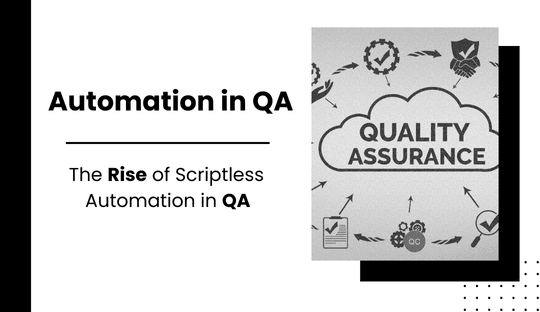
The Rise of Scriptless Automation in QA
In the fast-paced world of software development, ensuring quality while maintaining speed is crucial. Traditional Quality Assurance (QA) methods often struggle to keep up with the demands of modern development cycles. Enter scriptless automation in QA—a revolutionary approach that is transforming the landscape of software testing. For creative brand companies like Flykez CO in Hungary, adopting scriptless automation can lead to significant improvements in efficiency and reliability. This blog post explores the rise of scriptless automation in QA, highlighting its benefits, trends, and future outlook.
Focus Keywords: QA Testing Trends 2024, Hybrid Testing Models, Mobile Testing with 5G, Multi-Device Testing, AI in QA Testing
What is Scriptless Automation?
Scriptless automation refers to the use of tools and platforms that enable automated testing without the need for extensive coding. These tools offer intuitive interfaces, often based on drag-and-drop functionalities, which allow testers to create and execute automated tests with minimal or no scripting knowledge.
Benefits of Scriptless Automation
- Ease of Use: Scriptless tools are designed to be user-friendly, enabling non-technical testers to participate in automation efforts.
- Faster Time-to-Market: By reducing the complexity and time required to create automated tests, scriptless automation accelerates the testing process.
- Cost-Effective: It reduces the need for specialized coding skills, lowering the costs associated with training and hiring.
- Maintainability: Scriptless tests are easier to maintain and update, ensuring that automation assets remain relevant as the application evolves.
Focus Keywords: QA Testing Trends 2024, AI in QA Testing
Key Trends in Scriptless Automation
1. Integration of AI and Machine Learning
AI and machine learning are playing a pivotal role in enhancing scriptless automation tools. These technologies can analyze test data to identify patterns, predict failures, and optimize test coverage.
Example: AI-driven tools like Testim and Mabl leverage machine learning algorithms to improve test accuracy and efficiency by adapting to changes in the application.
Focus Keywords: AI in QA Testing
2. Hybrid Testing Models
Hybrid testing models, which combine manual and automated testing, are becoming increasingly popular. Scriptless automation tools fit seamlessly into these models by enabling easy switching between manual and automated tests as needed.
Example: Tools like Katalon Studio support hybrid testing approaches, allowing testers to choose the best testing method for each scenario.
Focus Keywords: Hybrid Testing Models
3. Mobile Testing with 5G
The advent of 5G technology is revolutionizing mobile testing. Scriptless automation tools are evolving to handle the increased complexity and performance demands of mobile applications in a 5G environment. Also Read About IoT Testing: Challenges and Solutions for Smart Devices
Example: Tools like Appium are enhancing their capabilities to support comprehensive testing of mobile applications on 5G networks.
Focus Keywords: Mobile Testing with 5G
4. Multi-Device Testing
With the proliferation of devices and platforms, ensuring compatibility across multiple devices is essential. Scriptless automation tools are expanding their support for multi-device testing to cover a wide range of devices and operating systems.
Example: BrowserStack and Sauce Labs provide extensive multi-device testing capabilities, enabling testers to ensure consistent performance across various devices.
Focus Keywords: Multi-Device Testing
Implementing Scriptless Automation at Flykez CO
For Flykez CO, incorporating scriptless automation into your QA strategy can significantly enhance your development process. Here’s how you can get started:
1. Choose the Right Tools
Select scriptless automation tools that align with your specific testing needs and workflows. Consider factors such as ease of use, integration capabilities, and support for different testing environments.
2. Train Your Team
Provide training sessions to familiarize your team with the chosen tools. Focus on leveraging the intuitive features of scriptless automation to empower non-technical team members.
3. Integrate with Existing Processes
Ensure that your scriptless automation efforts integrate seamlessly with your current development and QA processes. This includes aligning automation workflows with your CI/CD pipeline for continuous testing.
4. Monitor and Optimize
Regularly monitor the performance of your automated tests and make necessary adjustments to improve efficiency and coverage. Utilize the analytics and reporting features of scriptless tools to gain insights into test results and areas for improvement.
Future Outlook
The future of QA testing is poised for exciting advancements with scriptless automation at the forefront. As tools continue to evolve, incorporating more AI and machine learning capabilities, the barriers to effective automated testing will continue to diminish. Companies like Flykez CO can leverage these advancements to stay ahead of the curve, ensuring high-quality software delivery in an increasingly competitive market.
Focus Keywords Recap: QA Testing Trends 2024, Hybrid Testing Models, Mobile Testing with 5G, Multi-Device Testing, AI in QA Testing
By embracing scriptless automation, Flykez CO can enhance its QA processes, reduce time-to-market, and maintain high standards of software quality. For more insights and personalized strategies, visit Flykez CO.
